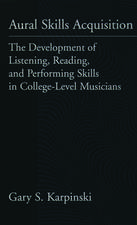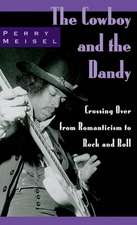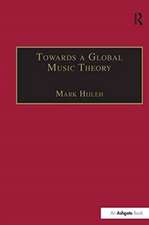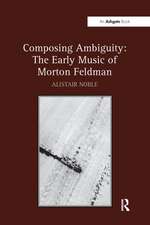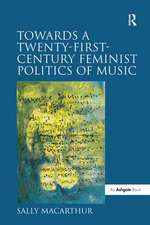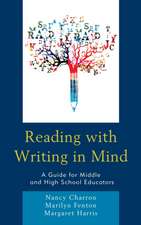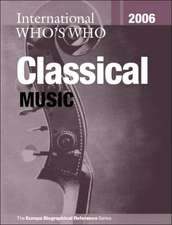Children’s Guided Participation in Jazz Improvisation: A Study of the ‘Improbasen’ Learning Centre: SEMPRE Studies in The Psychology of Music
Autor Guro Gravem Johansenen Limba Engleză Paperback – 30 noi 2021
Improbasen is a Norwegian private learning centre that offers beginner's instrumental tuition within jazz improvisation for children between the ages of 7 and 15. This book springs out of a two-year ethnographic study of the teaching and learning activity at Improbasen, highlighting features from the micro-interactions within the lessons, the organisation of Improbasen, and its international activity.
Music teachers, students, and scholars within music education as well as jazz research will benefit from the perspectives presented in the book, which shows how children systematically acquire tools for improvisation and shared codes for interplay. Through a process of guided participation in jazz culture, even very young children are empowered to take part in a global, creative musical practice with improvisation as an educational core.
This book critically engages in current discussions about jazz pedagogy, inclusion and gender equity, beginning instrumental tuition, creativity, and authenticity in childhood.
| Toate formatele și edițiile | Preț | Express |
|---|---|---|
| Paperback (1) | 309.75 lei 3-5 săpt. | +16.59 lei 6-12 zile |
| Taylor & Francis – 30 noi 2021 | 309.75 lei 3-5 săpt. | +16.59 lei 6-12 zile |
| Hardback (1) | 999.51 lei 6-8 săpt. | |
| Taylor & Francis – 30 noi 2020 | 999.51 lei 6-8 săpt. |
Din seria SEMPRE Studies in The Psychology of Music
-
 Preț: 200.41 lei
Preț: 200.41 lei -
 Preț: 341.55 lei
Preț: 341.55 lei -
 Preț: 280.95 lei
Preț: 280.95 lei -
 Preț: 341.55 lei
Preț: 341.55 lei -
 Preț: 265.72 lei
Preț: 265.72 lei -
 Preț: 415.87 lei
Preț: 415.87 lei -
 Preț: 355.48 lei
Preț: 355.48 lei -
 Preț: 449.41 lei
Preț: 449.41 lei -
 Preț: 445.18 lei
Preț: 445.18 lei -
 Preț: 449.41 lei
Preț: 449.41 lei -
 Preț: 361.08 lei
Preț: 361.08 lei - 18%
 Preț: 1005.80 lei
Preț: 1005.80 lei - 12%
 Preț: 328.59 lei
Preț: 328.59 lei - 13%
 Preț: 324.86 lei
Preț: 324.86 lei - 26%
 Preț: 819.09 lei
Preț: 819.09 lei -
 Preț: 449.41 lei
Preț: 449.41 lei - 18%
 Preț: 1001.51 lei
Preț: 1001.51 lei - 26%
 Preț: 764.20 lei
Preț: 764.20 lei -
 Preț: 488.29 lei
Preț: 488.29 lei - 26%
 Preț: 819.90 lei
Preț: 819.90 lei -
 Preț: 449.41 lei
Preț: 449.41 lei -
 Preț: 449.41 lei
Preț: 449.41 lei -
 Preț: 417.20 lei
Preț: 417.20 lei - 18%
 Preț: 1109.99 lei
Preț: 1109.99 lei - 18%
 Preț: 1055.66 lei
Preț: 1055.66 lei - 18%
 Preț: 1106.81 lei
Preț: 1106.81 lei -
 Preț: 411.42 lei
Preț: 411.42 lei - 18%
 Preț: 1112.41 lei
Preț: 1112.41 lei - 26%
 Preț: 849.37 lei
Preț: 849.37 lei - 18%
 Preț: 1000.27 lei
Preț: 1000.27 lei -
 Preț: 416.22 lei
Preț: 416.22 lei - 18%
 Preț: 1000.27 lei
Preț: 1000.27 lei
Preț: 309.75 lei
Nou
59.27€ • 61.88$ • 49.05£
Carte disponibilă
Livrare economică 14-28 martie
Livrare express 27 februarie-05 martie pentru 26.58 lei
Specificații
ISBN-10: 0367628066
Pagini: 204
Ilustrații: 38
Dimensiuni: 156 x 234 x 11 mm
Greutate: 0.3 kg
Ediția:1
Editura: Taylor & Francis
Colecția Routledge
Seria SEMPRE Studies in The Psychology of Music
Locul publicării:Oxford, United Kingdom
Cuprins
Notă biografică
Recenzii
'Guro Gravem Johansen’s Children’s Guided Participation in Jazz Improvisation stands as an important contribution to jazz and improvised music scholarship, focusing on the experiences of individuals who are not commonly considered in the music’s literature. Drawing upon the fields of musicology, ethnography, music education, Johansen both builds upon and offers alternatives to existing scholarship in jazz and musical learning that will find a warm and receptive audience. In the introductory chapter, Johansen makes the case for her study, noting that jazz researchers have tended to ignore “children playing jazz”. But children are, as she points out, among the most active and receptive of musical learners. The jazz community’s lack of direct engagement with children’s experiences in the music calls for a corrective, which Johansen provides in subsequent chapters through a close examination of Improbasen, a Norwegian learning center which focuses on the facilitation of improvisation in children. Chapter 3, for example, describes the nature of the center, tracing its development, demographic profile, and underlying principles, or the “way” that musical learning at Improbasen is structured and practiced. Central to these principles, Johansen writes, is the desire of Improbasen’s founder to “unite all the world’s children in jazz.” In a later chapter, Johansen engages more deeply with children’s engagement with a genre that is “constructed as adult’s music”. In examining Improbasen’s programs for teaching jazz to children, Johansen also calls into question the very notion of jazz as “adult music”. The desire to have children play jazz, while still being true to their “authentic” selves as children, serves as a catalyst for a deep, probing discussion of embedded assumptions about jazz, childhood, creativity, and identity. In closing, I am happy to endorse Johansen’s book, as it is a deeply researched and engagingly written study. I will look forward to seeing it in print, and I am confident that it will stimulate spirited debate among jazz communities, and in the field of musical learning in general.' Ken Prouty, PhD, Associate Professor, Musicology and Jazz Studies, Michigan State University, USA
'Guro Gravem Johansen’s new book, Children’s Guided Participation in Jazz Improvisation, provides an innovative ethnography of the Improbasen school’s creative approach to teaching jazz improvisation to children and young people between the ages of seven and fifteen. Johansen carefully documents how Improbasen teaches young children how to improvise as they learn their individual instruments and become musicians capable of performing with others. There are many noteworthy pedagogical innovations in the Improbasen curriculum including teaching gender and ethnic inclusion, and ethical modes of social interaction. Johansen’s analysis emphasizes the creation of micro-communities through musical improvisation and the school’s critique of traditional modes of jazz pedagogy. Especially noteworthy is Johansen’s documentation of Improbasen’s emphasis on gender inclusivity from an early age, which successfully results in the full participation of female students in what is often regarded as a masculine art form. In demonstrating the capability of the female students, Johansen shows how the study of children’s acquisition of musical skills can have socially transformative results.' Ingrid Monson, Quincy Jones Professor of African-American Music, Department of African American Studies, Harvard University, USA
'Guro Gravem Johansen’s Children’s Guided Participation in Jazz Improvisation stands as an important contribution to jazz and improvised music scholarship, focusing on the experiences of individuals who are not commonly considered in the music’s literature. Drawing upon the fields of musicology, ethnography, music education, Johansen both builds upon and offers alternatives to existing scholarship in jazz and musical learning that will find a warm and receptive audience. In the introductory chapter, Johansen makes the case for her study, noting that jazz researchers have tended to ignore “children playing jazz”. But children are, as she points out, among the most active and receptive of musical learners. The jazz community’s lack of direct engagement with children’s experiences in the music calls for a corrective, which Johansen provides in subsequent chapters through a close examination of Improbasen, a Norwegian learning center which focuses on the facilitation of improvisation in children. Chapter 3, for example, describes the nature of the center, tracing its development, demographic profile, and underlying principles, or the “way” that musical learning at Improbasen is structured and practiced. Central to these principles, Johansen writes, is the desire of Improbasen’s founder to “unite all the world’s children in jazz.” In a later chapter, Johansen engages more deeply with children’s engagement with a genre that is “constructed as adult’s music”. In examining Improbasen’s programs for teaching jazz to children, Johansen also calls into question the very notion of jazz as “adult music”. The desire to have children play jazz, while still being true to their “authentic” selves as children, serves as a catalyst for a deep, probing discussion of embedded assumptions about jazz, childhood, creativity, and identity. In closing, I am happy to endorse Johansen’s book, as it is a deeply researched and engagingly written study. I will look forward to seeing it in print, and I am confident that it will stimulate spirited debate among jazz communities, and in the field of musical learning in general.' Ken Prouty, PhD, Associate Professor, Musicology and Jazz Studies, Michigan State University, USA
'Through its descriptions of how learning to improvise enables children to develop the ability to think in music, Johansen’s book is not only a powerful plea in defence of difference and diversity in jazz improvisation education, but also regarding improvisation as a central activity in music pedagogy generally...There is no doubt that her detailed and well-reasoned account of Improbasen’s methods for teaching children jazz improvisation – peculiar as they may undoubtedly seem to some – provides valuable food for thought to music education research in general and to jazz educators in particular.'
Sven Bjerstedt, Lund University, Lund, Sweden
"Why is a book about a pedagogical jazz project in Oslo relevant for the international community? Firstly, it gives voice to Norwegian perspectives on learning jazz in a discourse that is largely shaped by North Americans. Secondly, it presents an ethnographic approach to the study of jazz, but in contrast to well-known ethnomusicological studies like those of Berliner (1994) and Monson (1996), it doesn’t focus on professional musicians but on children and their learning processes in jazz, addressing numerous essential pedagogical questions. And thirdly, it fills a certain gap (regarding scientific studies and didactic material) by discussing teaching approaches for children learning jazz in the very first years on an instrument...The book sophisticatedly discusses possible answers to this very question, resulting from a detailed study of the teaching approach and the learning processes taking place at “Improbasen,” a private jazz learning center for children in Oslo. Remarkable is the fact that jazz is not seen there as something for those who already have been trained in classical music or who have achieved whatever may be seen as instrumental basics elsewhere, but as core content for “children who have never played an instrument before” (p. 2). This book comprehensively documents and reflects pedagogical practice and knowledge regarding the first years of instrumental learning in the context of jazz and thus represents a highly relevant contribution for the actual discourse in jazz education...From the perspective of creative music pedagogy, it is stated that children should get the space to freely explore without the exclusive necessity of certain skills, in order to create their own music...Is jazz an adult music that is superimposed on the children? What can be the response to the critique, that possibly “children do not truly learn to improvise, only to copy and obey rules,” as Johansen points out (p. 4)? These questions are crucial ones for a jazz education dealing with children. Johansen acknowledges this criticism and in fact detects a great instructiveness and teacher-centeredness with given musical material connected to a certain tradition at Improbasen. But she also argues that these components provide a valuable process of interaction and empowerment: “Nevertheless, [the children’s] ability to draw on a shared repertoire of form and codes, as well as their social agency in instructing each other in what to do, point to their proximal development ahead and show that their training had empowered them enough to perform independently” (p. 167). She describes the approach of Improbasen—as the book title suggests—as a guidance toward the participation in jazz improvisation as an “adult knowledge culture,” referring to theories from psychologist Barbara Rogoff (1990) and sociologist Karin Knorr Cetina (1999)."
Julian Schunter, Jazz Education in Research and Practice Vol. 4, No. 1
Descriere
Improbasen is a Norwegian private learning centre that offers beginner's instrumental tuition within jazz improvisation for children between the ages of 7 and 15. This book springs out of a two-year ethnographic study of the teaching and learning activity at Improbasen, highlighting features from the micro-interactions within the lessons, the organisation of Improbasen, and its international activity.
Music teachers, students, and scholars within music education as well as jazz research will benefit from the perspectives presented in the book, which shows how children systematically acquire tools for improvisation and shared codes for interplay. Through a process of guided participation in jazz culture, even very young children are empowered to take part in a global, creative musical practice with improvisation as an educational core.
This book critically engages in current discussions about jazz pedagogy, inclusion and gender equity, beginning instrumental tuition, creativity, and authenticity in childhood.



